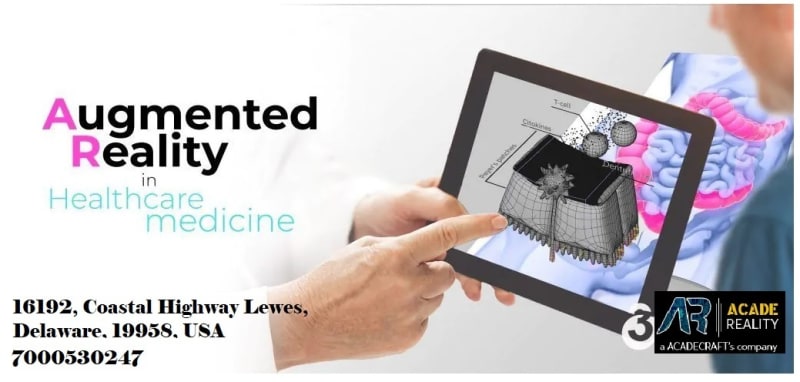Alternate realities offer a million possibilities for healthcare. Mixed reality (MR), virtual reality (VR), and Augmented reality (AR) are not only empty slogans in medicine but also valid answers in education, surgical or vein visualization, speeding up recovery in physical therapy, curing PTSD, relaxing patients,– or even supporting medical exhibitions.
The technology has advanced to the point where top-quality AR experiences are possible at affordable price points and should be extensively available to customers within a year. There are a few sectors that have been making use of AR technology for decades, and healthcare is one of them.
The development and appropriation of augmented reality in medicine
In the 90's, scholars began to exploit the potential of virtual reality and augmented reality medical to create a scheme that helps patients fight their phobias, addictions, and anxieties to overcome their fears. Augmented reality medicine translates into immersion in a different world, which provides a playful way to work on oneself and a sense of security to patients.
It comes closer to the medical industry by classifying itself as a healing tool and not as an amusing tool particularly dedicated to video games.
The development of augmented reality medicine was emphasized when academics studied the instance of burn victims, looking at how to decrease pain by creating a digital environment of snowy landscapes, for instance. Augmented reality and virtual reality provide a new dimension to medicine: it allows the remote while helping patients and doctors on a day-to-day basis.
Top instances examples of augmented reality in the healthcare and medical sector
1) Teaching learners about the human body
Curiscope, a UK-based firm, creates immersive learning experiences in augmented reality in healthcare. They established the Virtuali-tee T-shirt, through which you can see the internal parts of the human physique through accurate holograms. Virtuali-tee brings structure to life to such a point of illusion, which now represents Arthur C. Clarke's famous third law. "Any effectively progressive technology is vague from magic."
2) Patients can define their symptoms better through augmented reality
Patients often wonder how to describe their symptoms to doctors accurately. In other instances, individuals often find themselves exaggerating a medical situation – or, on the contrary, demeaning the problem. Using apps like Oculenz, surgeons can show the simulation of the image of a patient suffering from a particular condition.
In ophthalmology, augmented reality in healthcare might be the solution for patient education.
3) Nurses can find veins more easily with augmented reality
Medtech start-up AccVein is using Augmented reality in medical education to make both patients and nurses ' lives easier. AccuVein's advertising specialist, Vinny Luciano, said 40% of intravenous injections (IVs) miss the vein on the primary stick, with the figures getting worse for older people and children.
By using augmented reality, the agency can help medical specialists get better at getting blood, using a handheld scanner that projects over the skin and shows doctors and nurses where veins are in the patients' bodies.
4) Motivating runners through zombies
Visualize that you are walking through an abandoned and dark alley, and you suddenly see the slow movement and hear the groaning of a strange creature. I am sure that even an ideal person would speed up after recognizing that an actual zombie" is after them. This is the simple idea behind the app: Zombies, Run!
This app is ideal for those who consider consecutively an unexciting activity. If you do not see virtual zombies projected onto your device or phone but also hear them, you will not only grow your speed and stamina but also feel that time is just hovering by.
5) Pharma business offering more innovative drug data
Have you ever been questioned about how a drug functions in your body? Even if you got attentive in learning how the distant world of medications and pills works, I bet you mislaid all your eagerness after you read the indecipherable and boring drug description. Now, augmented reality in medical education is here to change it.
With the assistance of augmented reality medicine, patients can see how the medicine works in 3D in front of their eyes instead of reading long portrayals on the bottle. Lab employees could observe their experiments with augmented reality equipment.
6) Augmented reality can help surgeons in the OR
Patients and doctors are aware of the fact that when it comes to operation, accuracy is of prime prominence. Now, augmented reality in healthcare can assist doctors in becoming more efficient at operations.
Whether you are locating a tumor in the liver or they are conducting a minimally invasive procedure, Augmented reality in healthcare apps can help treat patients and save lives seamlessly.
Sync AR advanced a software program to give doctors "X-ray vision" by fusing virtually improved images openly into the microscope of a surgical device.
Wrapping up
Augmented reality in healthcare is still in its primary days in terms of widespread clinical use and adoption and breakthrough treatment paradigms. Reformers in this field will be gradually scrutinized regarding proof of clinical efficiency through accurately designed and meticulous human trials.
In the (not too distant) future, things will get really exciting with the unified intersection and integration of technologies like increasing computing power, biofeedback, big data analytics, deep learning, and AR with artificial intelligence.



Top comments (0)